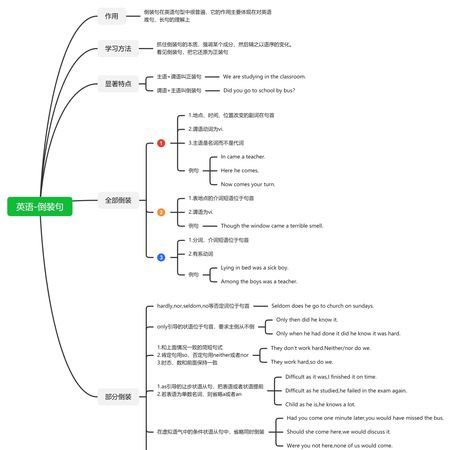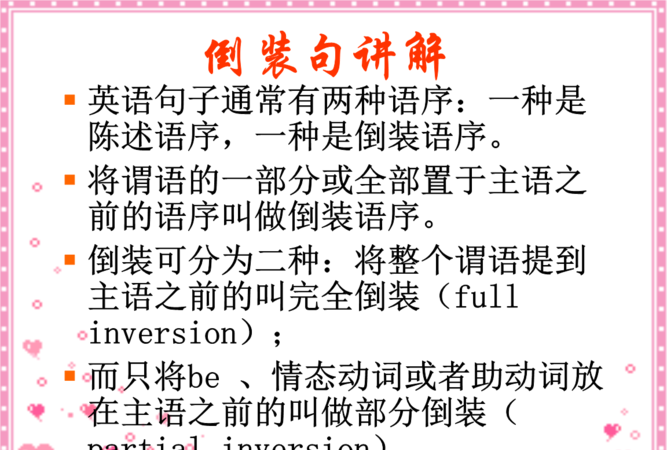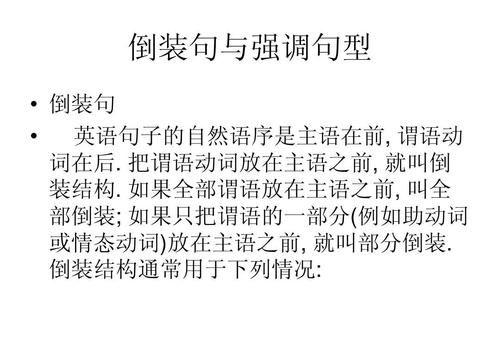本文目录
neither用于倒装句结构是什么?
英语句子表达的基本语序是“主语+谓语”。但在实际应用中,因语法结构的需要,或是为了强调,常把谓语移到主语之前,称为倒装。

什么是倒装句
倒装句分为全部倒装和部分倒装。全部倒装即把谓语提到主语之前,部分倒装即把谓语动词中一部分提到主语之前。究其原由,一是语法需要,二是修辞需要。但在实际应用中,特别是在复合句中,学生常常分不清楚是在主句中倒装,还是在从句中倒装。下面就中学英语中的这种现象加以列举。
(一)在主句中倒装
1. not only…but also…连接两个对等成分时
Not only was everything he had taken away from him, but also his German citizenship.
Not only should we not be afraid of difficulties, but we should overcome them.
2. so…that… 结构中,强调so 所修饰的词时,句子倒装
So loudly did he speak that every one of the class could hear him.
So shallow is the lake that no fish can live in it .
3. hardly (scarcely) …when…,no sooner…than…结构中,强调否定意义的词时
Hardly had I reached the bus stop when the bus started.
No sooner had he arrived home than he was asked to start on another journey.
4. not until位于句首时
Not until all the fish died in the river did the villagers realized how serious the problem was.
5. 有时为了平衡句子
Gone are the days when we used“foreign oil”.
At last came the day when he was to be thrown to the prison.
(二)在从句中倒装
1. as引导的让步状语从句中倒装
Child as he was, he knows a great deal.
Disabled as Paul was, he went on serving the people.
2. 虚拟语气中,如从句谓语含were, had should,则省去if用倒装
Were I not working, I would be quite willing to do what you ask me to.
Had I known, I might have joined you in the discussion.
3. 介词+关系代词引导的定语从句中
They arrived at a farmhouse, in front of which sat a small boy

倒装句的结构是什么
倒装句之全部倒装
全部倒装是只将句子中的谓语动词全部置于主语之前.此结构通常只用与一般现在时和 一般过去时.常见的结构有:
1) here, there, now, then, thus等副词置于句首, 谓语动词常用be, come, go, lie, run.
There goes the bell.
Then came the chairman.
Here is your letter.
2) 表示运动方向的副词或地点状语置于句首,谓语表示运动的动词.
Out rushed a missile from under the bomber.
Ahead sat an old woman.
注意:上述全部倒装的句型结构的主语必须是名词,如果主语是人称代词则不能完全倒装.
Here he comes. Away they went.
倒装句之部分倒装
部分倒装是指将谓语的一部分如助动词或情态倒装至主语之前.如果句中的谓语没有助动词或情态动词,则需添加助动词do, does或did,并将其置于主语之前.
1) 句首为否定或半否定的词语,如no, not, never, seldom, little, hardly, at no time, in no way, not until… 等.
Never have I seen such a performance.
Nowhere will you find the answer to this question.
Not until the child fell asleep did the mother leave the room.
当Not until引出主从复合句,主句倒装,从句不倒装.
注意: 如否定词不在句首不倒装.
I have never seen such a performance.
The mother didn't leave the room until the child fell asleep.
典型例题
1) Why can't I smoke here?
At no time___ in the meeting-room
A. is smoking permitted B. smoking is permitted
C. smoking is it permitted D. does smoking permit
答案A. 这是一个倒装问题.当否定词语置于句首以表示强调时,其句中的主谓须用倒装结构. 这些否定词包括no, little, hardly, seldom, never, not only, not until等.本题的正常语序是 Smoking is permitted in the meeting-room at no time.
2) Not until the early years of the 19th century ___ what heat is.
A. man did know B. man know C. didn't man know D. did man know
答案D. 看到Not until…的句型,我们知道为一倒装句,答案在C,D 中选一个.
改写为正常语序为,Man did not know what heat is until the early years of the 19th. 现在将not提前,后面就不能再用否定了,否则意思就变了.
以否定词开头作部分倒装
如 Not only…but also, Hardly/Scarcely…when, No sooner… than
Not only did he refuse the gift, he also severely criticized the sender.
Hardly had she gone out when a student came to visit her.
No sooner had she gone out than a student came to visit her.
典型例题
No sooner___ than it began to rain heavily.
A. the game began B. has the game begun
C. did the game begin D. had the game begun
答案D. 以具有否定意义的副词放在句首时,一般采用倒装句(谓语前置).这类表示否定意义的词有never, seldom, scarcely, little, few, not, hardly, 以及not only…but (also), no sooner…than, hardly… when scarcely… when 等等.
注意:只有当Not only… but also连接两个分句时,才在第一个分句用倒装结构.如果置于句首的Not only… but also仅连接两个并列词语,不可用倒装结构.
Not only you but also I am fond of music.
so, neither, nor作部分倒装
表示"也"、"也不" 的句子要部分倒装.
Tom can speak French. So can Jack.
If you won't go, neither will I.
典型例题
---Do you know Jim quarrelled with his brother?
---I don't know, _____.
A. nor don't I care B. nor do I care C. I don't care neither D. I don't care also
答案:B. nor为增补意思"也不关心",因此句子应倒装.A错在用 don't 再次否定, C neither 用法不对且缺乏连词. D缺乏连词.
注意: 当so引出的句子用以对上文内容加以证实或肯定时,不可用倒装结构.意为"的确如此".
Tom asked me to go to play football and so I did.
---It's raining hard. ---So it is.
only在句首要倒装的情况
Only in this way, can you learn English well.
Only after being asked three times did he come to the meeting.
如果句子为主从复合句,则主句倒装,从句不倒装
Only when he is seriously ill, does he ever stay in bed.
as, though 引导的倒装句
as / though引导的让步从句必须将表语或状语提前 (形容词, 副词, 分词, 实义动词提前).
注意:
1) 句首名词不能带任何冠词.
2) 句首是实义动词, 其他助动词放在主语后.如果实义动词有宾语和状语, 随实义动词一起放在主语之前.
Try hard as he will, he never seems able to do the work satisfactorily.
注意:
让步状语从句中,有though,although时,后面的主句不能有but,但是 though 和yet可连用.
其他部分倒装
1) so… that 句型中的so 位于句首时,需倒装.
So frightened was he that he did not dare to move an inch.
2) 在某些表示祝愿的句型中:
May you all be happy.
3) 在虚拟语气条件句中从句谓语动词有were, had, should等词,可将if 省略,把 were, had, should 移到主语之前,采取部分倒装.
Were I you, I would try it again.
典型例题:
1) Not until the early years of the 19th century___ what heat is
A. man did know B. man knew C. didn't man know D. did man know
答案为D. 否定词Not在句首,要求用部分倒装的句子结构.
2) Not until I began to work ___ how much time I had wasted.
A. didn't I realize B. did I realize C. I didn't realize D. I realize
答案为B.
3) Do you know Tom bought a new car?
I don't know, ___.
A. nor don't I care B. nor do I care
C. I don't care neither D. I don't care also
解析:答案为B. 句中的nor引出部分倒装结构,表示"也不".由 so, neither, nor引导的倒装句,表示前一情况的重复出现.其中, so用于肯定句, 而 neither, nor 用在否定句中.

英语中倒装句的结构和用法浅析
说具体点吧:
1.only+状语
Only in this way can you learn English well.
2.否定副词开头或含有否定词的介词短语开头
Never have I seen such a strange man!
3.so+形容词或副词开头或类似以such开头的
So frightened she was that she couldn't say a word.
4.介副词开头的表语或表语从句
The door opened. In came his father.
5.if引导的虚拟条件从句省略if时
Had I known his name, I would have told you.
6.as作让步状语的特殊结构
Young as he is, he is experienced.
7.so,nor,neither开头表示情况相同:
I like watching movies. So does my brother.

以上就是关于倒装句式的基本结构 ,neither用于倒装句结构是什么?的全部内容,以及倒装句式的基本结构 的相关内容,希望能够帮到您。
